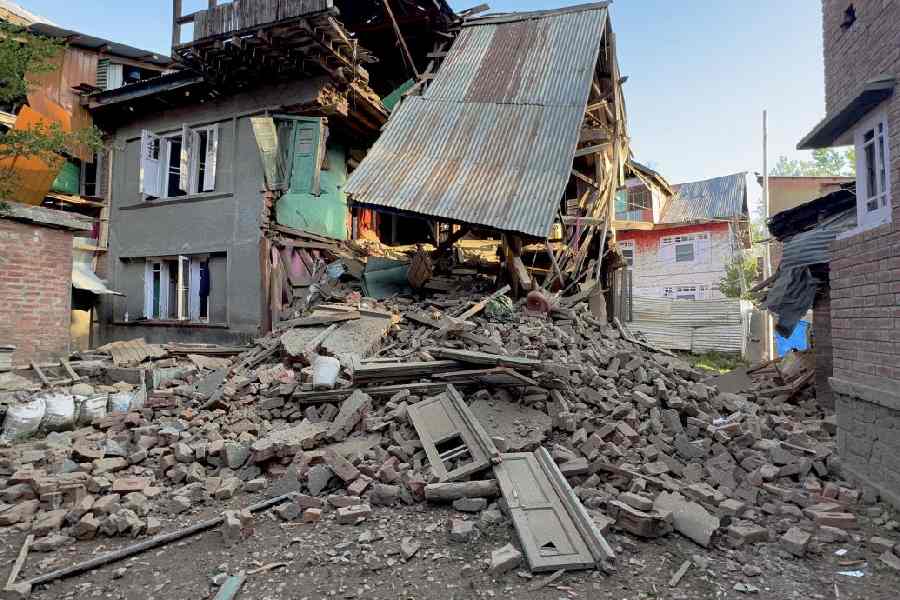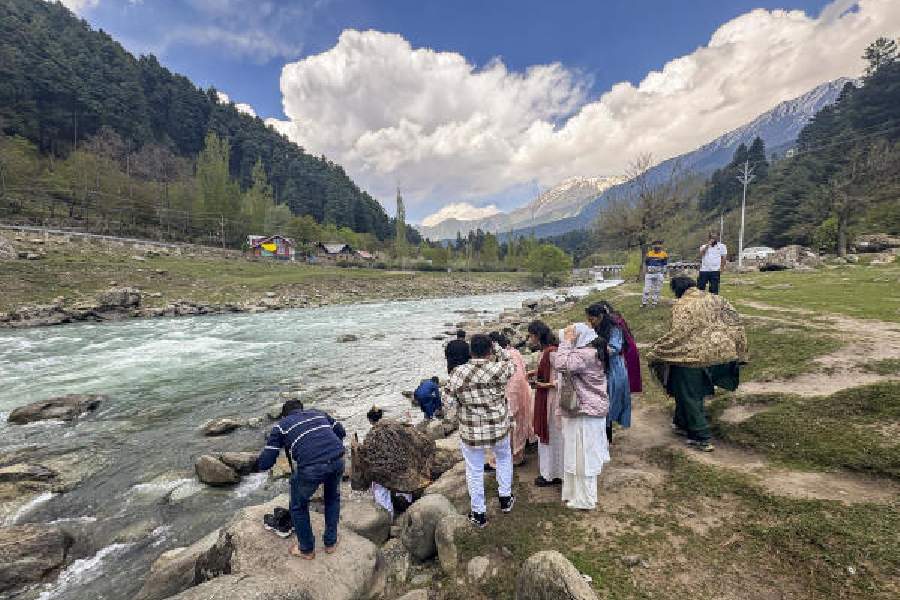The cluster of mud-brick houses owned by the Panja family tells a tale of death behind many doors.
The Panjas of Mahishtikari village in Singur, off the Durgapur Expressway just across the abandoned Nano factory, have lost four loved ones in the past five years.
All of them, claims Bimal Panja, farmer and head of the household, died of cancer caused by pollution from the factory under whose shadow the village lives. The coal tar distillation factory is run by Himadri Chemicals & Industries Ltd, a company with an annual turnover of Rs 1,363 crore. Himadri has denied all the charges.
The following report has been written after months of research by a team of reporters from The Telegraph, which visited the area several times since August last year. The reporters documented the claims and health records of the family members of people who have either died in recent years or are thought to be suffering from cancer.
The reporters consulted Srabani Mittal, a physician working on preventive oncology; her team of doctors; Udayan Das, a physician in Singur; Arunava Majumdar, a former director at the All India Institute of Hygiene and Public Health; and Dipak Chakrabarty, who retired as chief scientist from the state pollution control board.
The journalists also collected water samples from two water bodies in the village and got them tested. Himadri officials took the reporters around the plant and spoke to them to put forward their version.
A factor that stood out during the multiple visits by the reporters to the village was a plea by the villagers that the factory should not be shut down — they depend on it for their livelihood.
All they wanted was a conclusion beyond doubt through an independent probe that the cancers and other diseases are not caused by emission from the plant.
Three days ago, on July 8, the National Green Tribunal’s principal bench in New Delhi directed the Central Pollution Control Board to inspect the plant in order to ascertain whether it has taken all necessary measures for checking air and water pollution caused by hazardous waste. The central board has also been directed to find out whether the industry is discharging effluent into drains leading to the agricultural fields or water bodies in the vicinity.
The tribunal order said: “Photographs (submitted by a Mahishtikari forum)… depict that something is seriously wrong in the vicinity of the industry. However, the consent to operate (issued by the West Bengal Pollution Control Board on April 22, 2014) suggests that the WBPCB was satisfied with the manner in which the industry is being run….”
The plant
The Himadri plant is a sprawling installation — with a 24x7 production process that yields per year nearly 3 lakh tonnes of pitch, carbon black, naphthalene and several oils from one raw material, coal tar. It lights up the Durgapur Expressway at night like fireworks, offering a sharp contrast to the vast darkness of the abandoned Tata factory ruins.
Himadri has two power plants, run on gas distilled from coal tar, although only one is operational.
The factory was once declared “fit for closure” by the WBPCB. It was spared the blow in consideration of the fate of the workers, but some of its operations were suspended. In April, the Bengal board renewed the consent for Himadri to operate.
Cancer charge
The Panjas are not alone. Many in Mahishtikari claim that cancer has risen drastically since Himadri began its operations in 2005.
Almost all the houses in Mahishtikari are set within 500 metres of the factory. People from adjoining Kuleba too allege that cancer has risen in their village.
Bimal Panja lists the four family members who died: Panchanan Panja, 49, died in 2008; Gitarani Panja, 64, in 2010; Sushma Panja, 59, in 2010; and Tarubala Panja, 66, in 2013. Tarubala, Bimal’s mother, died of oesophageal cancer, he says.
“I don’t know who is next in line. Now, whenever anyone complains about a health problem, I panic,” says Bimal, pointing at his two young nieces, who he says suffer from skin infections acquired from the water around the village, contaminated with waste from the factory.
Archana, Bimal’s wife, complains constantly of dizziness and nausea caused by the stench from the factory, especially at “peak hours” during the night. Some days she can’t get up from bed. “It’s like living in a gas chamber,” says Archana.
The villagers list their dead: Anima Malik died of cancer in the gall bladder and liver in 2013; Harendranath Malik of colon cancer in 2012.
“All the cancer patients lived within less than half a kilometre of the factory and hence were being regularly exposed to toxic pollution,” says Bhaskar Dhara of Mahishtikari Paribesh Jibon Krishikalyan Mancha, the forum that has been fighting against the industry for quite some time and whose members contested the last panchayat elections solely on the environment plank.
Often, documents were unavailable because the families of the dead said they had thrown away all the belongings of the dead, including their medical papers. Residents complained of about 25 cancer deaths in the past few years in the locality but medical documents could be procured for about 10 cases.
Based on the available records, the doctors this newspaper consulted have suggested that six of the 10 patients had cancer and two were suspected cases. The records of the remaining two are not clear enough to reach a conclusion.
Family members and neighbours of the 10 villagers whose records were available -— and also of those who allegedly died of cancer but whose records have been destroyed — stress that the doctors they consulted had been treating the patients for cancer. Most of the patients died shortly after the onset of the disease.
“One needs a detailed, independent epidemiological study to establish the relationship between pollution released by the factory and cancers occurring in the neighbourhood. However, there is no denying that many possible output components in emissions and effluents of the factory are carcinogenic,” said Siddhartha Datta, a Jadavpur University professor who has researched chemical pollution.
‘No emissions’
Himadri denies its emissions are carcinogenic. In fact, it denies that there are any emissions at all.
Amit Choudhary, president (projects), Himadri, says “the factory uses a completely insulated emission control system and hence no fume can come out apart from the treated gas from the chimney”. It uses up all the by-products of the distillation process in the operation of its 12MW power plant and in other industrial processes, the company adds.
But the villagers complain of a “foul gas” which, they say, is released constantly by the factory. It peaks mostly at night and apparently the discomforts, including breathlessness, dizziness, pain in the head and nausea, are felt most at those times.
“It is unbearable, affecting our eyes and causing breathlessness,” says Khudiram Bag, whose house is about 500 metres from the factory.
Women in the houses closest to the factory say it is tough to feed milk to their children. The area is famous for milk products, including chhana. But if milk is left uncovered in the village even for a while, it is covered with black dust from the factory.
“We have to keep the window facing the factory closed at all times,” complains Ruma Aich, a homemaker.
Last year, The Telegraph team saw constant emission of black fumes from the chimney and also “fugitive emissions” — fumes escaping from other parts of the factory.
Workers emerged from the factory with their faces covered in soot. A tea stall owner outside the factory’s main gate said he was often not paid because he couldn’t recognise the men with blackened faces.
The surfaces of vegetables and leaves growing in the area were covered with a thick coat of black dust.
“The fumes released by the plant are a cocktail of toxic gases, many of which are known to be carcinogenic. Being predominantly aromatic, the mixture has strong odour,” a pollution board official said.
According to him, the fume is likely to contain particulates, oxides of carbon, oxides of nitrogen, elements like benzene, xylene and toluene, acidic gas and polyaromatic hydrocarbons (PAH) — many of which trigger the odour and are toxic and carcinogenic.
He said the peaks — as mentioned by local people —may occur at times when the coal tar distillation operation starts. “The amount of emission released is normally much more at the initiation of production,” he says.
The state pollution board is aware of the problem. An expert committee set up by the board in 2010 — after mass protests against pollution took place — held Himadri responsible for the “odour problem” and asked the factory management to make “all efforts… to control the same”.
An earlier board order had mentioned the “problem of… pungent smell….”
Himadri says it releases no gas other than water vapour, which has no smell. “We use up all the released gas in our 12MW plant to generate power and the proposed 8MW plant is a backup,” said Amit Choudhary, president (projects).
In January this year, Himadri was yet to obtain the clearance to set up the 8MW plant.
Veterans familiar with similar production processes felt that increased production could lead to an increase in the toxic gas. If the tail gas is not used to run the power plant and generate power, it is usually let out, they said.
The veterans said that Himadri may not have had the capacity to use all the gas as the licence to run the 8MW plant was awaited.
“The amount of tail gas produced should be proportional to the total production. As Himadri has enhanced its production significantly from 2011-12, the production of tail gas must have increased in similar proportion,” said Chakrabarty, the former chief scientist at the state pollution control board.
The team of officials who took The Telegraph team around the plant denied that emission had increased. Himadri insists that the production process is “100 per cent closed”, meaning the distillation and further processes use up every bit of the raw materials, either to make new products for sale or to make intermediate products that can be used in the factory’s other processes.
The directors’ report submitted to shareholders on May 15, 2012, says: “Since the company has expanded the capacity of its carbon black plant which has further necessitated to increase the corresponding capacity of its power plant … hence the company has enhanced its capacity from existing 12MW to 20MW”.
“During the year 2011-12, the company has successfully expanded the capacity of its carbon black project at Mahishtikary by 140%,” states the report submitted during the company’s last annual general meeting. It adds that “the company has started the expansion of its existing coal tar distillation capacity at Mahishtikary …by 60%”.
Not just cancer
Villagers spoke of several ailments, from cardiac to respiratory to skin to gastrointestinal.
“I have just returned from the hospital; I had to be admitted twice within a short span with impaired liver function as well as respiratory distress,” said Sandhya Bhowmick, a housewife, aged about 30. “Why cancer, all kinds of diseases have shot up since the industry was set up here,” complained another.
“The factory’s medical unit, which caters to both workers and villagers, is inundated with heart and respiratory complaints and often runs out of medicine,” said a young woman who works in the factory.
The company authorities themselves said that nearly 25,000 patients were treated in a year at the dispensary.
“There is no doubt that the complaints about cardiac and respiratory distress, insomnia, constant irritability, nausea, blackening of the skin and other infections, dizziness and pain in the head, gastrointestinal disorders, etc, have increased manifold in the locality after the industry was set up. We have also received some complaints about cancer. However, most cancer patients are likely to go to hospitals in Calcutta,” said local physician Udayan Das who has a nursing home in Singur.
Das had worked for a short duration with Himadri as a visiting doctor. Das says he left the job when he found that the medical support system was ornamental, not functional.
International experts corroborate that inhalation of, and skin and eye contact with, coal tar pitch volatiles are possible routes of carcinogenic infection. In 2012, the International Agency on Research on Cancer, under the World Health Organisation, confirmed the availability of “sufficient evidence in humans for the carcinogenicity of occupational exposures during coal-tar distillation”.
In many countries, the commercial use of coal tar, in roads and elsewhere, has been banned on environmental and public health grounds.
Himadri’s stand
“We do not know of any complaints. Ours is a state-of-the-art factory and we do not cause any pollution to the surroundings,” says Anurag Chowdhary, chief executive officer of Himadri.
The factory says that there is no smell at all around the factory. “Odour is a matter of perception,” says Soumen Chakrabarty, joint director of the company. A report on an ambient air pollution test carried out in the vicinity of the factory by Himadri also says there is “no remarkable smell”.
Dhara, an Independent candidate who contested the panchayat polls on the pollution plank but lost to a Trinamul nominee, complained that the state administration had not only turned a blind eye to the pollution from the factory but also sheltered it.
“We are continuously discouraged and even threatened, directly and indirectly, not only by the goons of the factory but also by the administration. The pollution control board directed closure of a part of the plant in 2010, but did nothing since then though the pollution spiralled. Recently, when we were trying to pursue our complaint against the industry in the high court, the officer in charge of the local Singur police station indirectly asked us not to proceed and threatened action in case of any organised protest against the industry,” said Dhara.
“Let there be an independent inquiry under judicial supervision into all related issues, including the complaints of pollution and spiralling diseases, including cancers,” said environment activist Subhas Datta.
what the water test showed
The water outside the Himadri factory premises, especially in the nayanjali, the canal that feeds the agricultural fields of the village, was dark when The Telegraph team went there last year.
Villagers claimed that the “poisoned water” was killing the fish and affecting agricultural production. This newspaper got the water from the nayanjali, as well as samples from a water body near the village, tested in June last year.
The levels of pollutants in both water samples, tested at a state pollution control board-recognised laboratory, were found to be above the national permissible limits.
In the nayanjali sample, the Biological Oxygen Demand (BOD), an indicator of organic pollution, was found to be 111mg/litre against a BOD effluent discharge limit of 30mg/litre.
The Chemical Oxygen Demand (COD), an indicator of chemical pollution, was at 553.2mg/l against the limit of 250mg/l. The oil and grease level was close to 1.5 times over the normal limit.
In the water body sample, the BOD level was more than 25 times the permissible limit — 80mg/litre compared to the surface water standard of 3mg/litre. The COD and the oil and grease discharge value were pegged at 316mg/l and 6.9 mg/l respectively, but there are no comparable values as chemical effluents are not supposed to be found in such water bodies at all.
The samples were collected on a rainy day. “These are extremely high values despite being measured in the monsoon, which shows the situation during summer must be much worse. Such high pollution, especially in water bodies used by people, may cause a spurt of skin and gastrointestinal problems,” said Arunava Majumdar, a former director of the All India Institute of Hygiene and Public Health.
He was part of the state pollution board’s expert committee formed in 2010 after mass protests against alleged pollution from the factory.
The West Bengal Pollution Control Board had issued a partial restriction of Himadri’s operations and observed that it wanted to close the factory for violation of environmental norms after it found that the level of oil and grease in the effluents was 2,057 milligrams per litre against the permissible limit of 10 milligrams per litre, apart from failures in “other parameters”.
It had then declared that the industry was “a fit case for closure” but refrained from issuing the order “considering the fate of the workers (almost 300)”. Himadri said it has nearly 2,200 permanent workers and close to 1,400 temporary workers.
The expert committee had also observed that the “effluent treatment plant (ETP)”
in the factory “has the arrangement to bypass the unit operations of the treatment plant”; which effectively means the plant can release untreated water directly outside.
Himadri insists nothing flows out of the factory. It did acknowledge the presence of oils in the nayanjali water outside the factory but insisted that the oils came from a different source: trucks being washed near the canal.
Jayanta Basu, Chandrima S. Bhattacharya and Uttam Dutta










